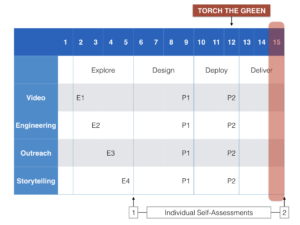 During the last week of class, the students celebrated their achievement by collaboratively editing, and then watching the final class video! Everyone did a fantastic job all semester long promoting Innovation at FSU! Check out the students’ class video online here: https://www.youtube.com/watch?v=s2GwSnt8new
During the last week of class, the students celebrated their achievement by collaboratively editing, and then watching the final class video! Everyone did a fantastic job all semester long promoting Innovation at FSU! Check out the students’ class video online here: https://www.youtube.com/watch?v=s2GwSnt8new
Posts
Week 14
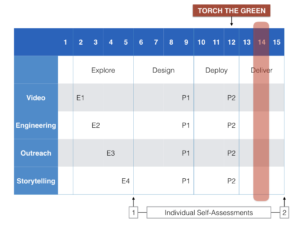 The students spent the second-to-last week of the course putting the finishing touches on their class video. They finished their filming, selected the best clips for use in the video, and decided on the final arrangement of the video. The stage was set for the video’s completion and premiere during the last week of class!
The students spent the second-to-last week of the course putting the finishing touches on their class video. They finished their filming, selected the best clips for use in the video, and decided on the final arrangement of the video. The stage was set for the video’s completion and premiere during the last week of class!
Week 13
 With the Innovation Flashmob on Landis Green now successfully completed, the students in class turned their attention toward finishing their own class video promoting Innovation at FSU.
With the Innovation Flashmob on Landis Green now successfully completed, the students in class turned their attention toward finishing their own class video promoting Innovation at FSU.
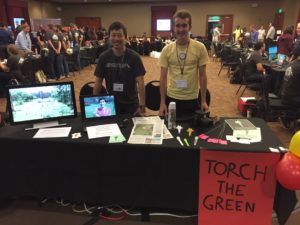 They also promoted their own work at FSU’s Digitech celebration on April 12, and learned more about the drone technology used to film the flash mob from FSU’s Emergency Management division.
They also promoted their own work at FSU’s Digitech celebration on April 12, and learned more about the drone technology used to film the flash mob from FSU’s Emergency Management division.
Week 12
 This is it! The week of the flash mob is finally here! After weeks of prep and planning, the day finally arrived, along with two days of severe thunderstorms that threatened to scuttle the operation… but on Thursday, April 6, the clouds cleared, the sun came out, and we had a gorgeous day for a flash mob!
This is it! The week of the flash mob is finally here! After weeks of prep and planning, the day finally arrived, along with two days of severe thunderstorms that threatened to scuttle the operation… but on Thursday, April 6, the clouds cleared, the sun came out, and we had a gorgeous day for a flash mob!
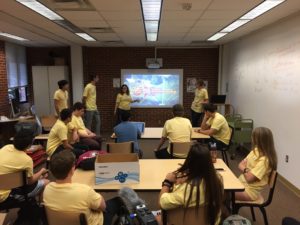 The students were out on the Green setting up the chalk outline at 11:00am. Photographers from university communications and social media took up their vantage points on the ground and on the roof of Strozier Library. And the folks from FSU Emergency Management brought their drones and prepared to film from the air! The students quickly assigned positions and roles, and at 1:00pm, every student in the class took a position on the Green, ready to pass out sheets of poster board!
The students were out on the Green setting up the chalk outline at 11:00am. Photographers from university communications and social media took up their vantage points on the ground and on the roof of Strozier Library. And the folks from FSU Emergency Management brought their drones and prepared to film from the air! The students quickly assigned positions and roles, and at 1:00pm, every student in the class took a position on the Green, ready to pass out sheets of poster board!
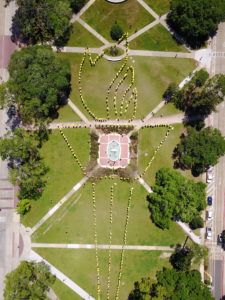 At 1:45pm, the drone took to the air, a few minutes later, President Thrasher arrived, and suddenly, out of nowhere, at 2:00pm, we had an FSU torch on Landis Green! In true flash mob style, it went from zero to 100 to zero in a matter of minutes… Amazing job by all the students!! Watch a short video clip courtesy FSU Emergency Management! FSU’s College of Communication and Information also assembled a fantastic video montage of the innovation flash mob showing all the students’ hard work coming together.
At 1:45pm, the drone took to the air, a few minutes later, President Thrasher arrived, and suddenly, out of nowhere, at 2:00pm, we had an FSU torch on Landis Green! In true flash mob style, it went from zero to 100 to zero in a matter of minutes… Amazing job by all the students!! Watch a short video clip courtesy FSU Emergency Management! FSU’s College of Communication and Information also assembled a fantastic video montage of the innovation flash mob showing all the students’ hard work coming together.
Week 11
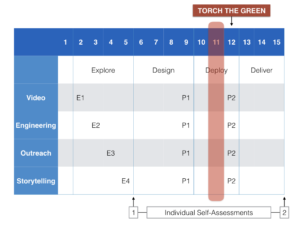 Week 11, the students’ final week for preparation before the actual flash mob itself, was crunch time for the students as they brought all their plans to bear — finalizing such things as advertising, timelines, and live-streaming. We used stickers and a Starbucks gift card raffle as a way to encourage other students to spread the word online, and tested the process of laying out 1000 sheets of gold poster board on the green. We also kept a careful eye on the weather forecast — after weeks of endless sun, rain was in the forecast for the following week, so we all kept our fingers crossed for fair weather on April 6th. All we needed to do now was make sure everyone knew their role to play, and all the pieces were in place to make FSU History!
Week 11, the students’ final week for preparation before the actual flash mob itself, was crunch time for the students as they brought all their plans to bear — finalizing such things as advertising, timelines, and live-streaming. We used stickers and a Starbucks gift card raffle as a way to encourage other students to spread the word online, and tested the process of laying out 1000 sheets of gold poster board on the green. We also kept a careful eye on the weather forecast — after weeks of endless sun, rain was in the forecast for the following week, so we all kept our fingers crossed for fair weather on April 6th. All we needed to do now was make sure everyone knew their role to play, and all the pieces were in place to make FSU History!
Week 10
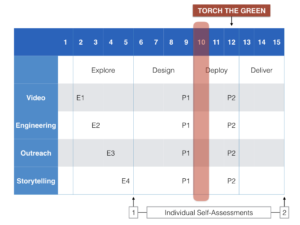 Week 10 welcomed the students back from Spring Break, and kicked the project into high gear — moving the class from the Design to the Deploy phase of the course. Team Storytelling worked together to nail down all the final items needed for them to make their video about Innovation at FSU. Team Video confirmed the placement of cameras on the top of Strozier Library (thanks to the kind efforts of the university librarians), and the aerial video from above the Landis Fountain (thanks to the awesome assistance of FSU Emergency Management). Team Engineering worked to test all of the materials (from spray chalk to poster boards), and worked on their plan for a timeline of the entire flashmob event — who is doing what when, who will be standing where, who is passing out poster board, etc. — making sure that every contingency is accounted for! Finally, Team Outreach ramped up their advertising efforts, distributing 500 flyers and spreading the word through all their channels! All the students in the class focused their efforts on building hype and making the event go viral!
Week 10 welcomed the students back from Spring Break, and kicked the project into high gear — moving the class from the Design to the Deploy phase of the course. Team Storytelling worked together to nail down all the final items needed for them to make their video about Innovation at FSU. Team Video confirmed the placement of cameras on the top of Strozier Library (thanks to the kind efforts of the university librarians), and the aerial video from above the Landis Fountain (thanks to the awesome assistance of FSU Emergency Management). Team Engineering worked to test all of the materials (from spray chalk to poster boards), and worked on their plan for a timeline of the entire flashmob event — who is doing what when, who will be standing where, who is passing out poster board, etc. — making sure that every contingency is accounted for! Finally, Team Outreach ramped up their advertising efforts, distributing 500 flyers and spreading the word through all their channels! All the students in the class focused their efforts on building hype and making the event go viral!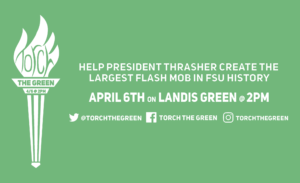
Week 09
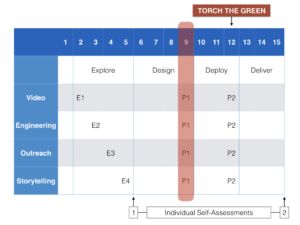 Students spent Week 09, the last week before Spring Break, finalizing their design plans. Team Video worked on all the different video perspectives needed for the flash mob, including aerial shots from above, photos from the roof of Strozier library, and 360 degree video cameras in the crowds. Team Storytelling worked on reaching out to the FSU Innovators to include in the class video about Innovation at FSU, and tested different approaches to videoing people with the 3d-printed FSU torch. Team Engineering finalized their plans for the layout of the torch on the green (flipping the torch end to end so that the base of the torch is at Strozier Library, with the flames reaching up toward Landis Hall) and worked on their plans for marking where everyone will stand holding gold poster board (we decided at this point that 1000 sheets of gold poster board would be the best way to replicate the 3d-printed gold torch on the green). Finally, Team Outreach worked on their advertising plans, finalizing flyers, stickers, social media promotions, tabling on the green, and reaching out to classes, professors, and students across campus. The student newspaper, FSView, ran a story about the class project, and the students wrapped up the week by handing in their team’s progress reports before heading out on Spring Break!
Students spent Week 09, the last week before Spring Break, finalizing their design plans. Team Video worked on all the different video perspectives needed for the flash mob, including aerial shots from above, photos from the roof of Strozier library, and 360 degree video cameras in the crowds. Team Storytelling worked on reaching out to the FSU Innovators to include in the class video about Innovation at FSU, and tested different approaches to videoing people with the 3d-printed FSU torch. Team Engineering finalized their plans for the layout of the torch on the green (flipping the torch end to end so that the base of the torch is at Strozier Library, with the flames reaching up toward Landis Hall) and worked on their plans for marking where everyone will stand holding gold poster board (we decided at this point that 1000 sheets of gold poster board would be the best way to replicate the 3d-printed gold torch on the green). Finally, Team Outreach worked on their advertising plans, finalizing flyers, stickers, social media promotions, tabling on the green, and reaching out to classes, professors, and students across campus. The student newspaper, FSView, ran a story about the class project, and the students wrapped up the week by handing in their team’s progress reports before heading out on Spring Break!
Week 08
 Students spent Week 08 working on testing the technologies for the flash mob, and culminated in a pilot test of the project on the green, with 50 students working together to approximate a torch shape directly in front of Landis Hall.
Students spent Week 08 working on testing the technologies for the flash mob, and culminated in a pilot test of the project on the green, with 50 students working together to approximate a torch shape directly in front of Landis Hall.
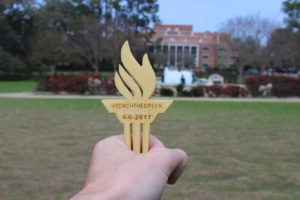 Team Video worked on identifying all the different shots they would need for the class video, and continued to assess our options for filming the flash mob from above. Team Storytelling identified the innovators at FSU who will be featured in the video, and finalized the storyboarding for the project. Team Outreach worked on their plans for advertising the project. And Team Engineering finalized the design for the 3D-printed torch, and tested different materials for use when laying out the torch on the green.
Team Video worked on identifying all the different shots they would need for the class video, and continued to assess our options for filming the flash mob from above. Team Storytelling identified the innovators at FSU who will be featured in the video, and finalized the storyboarding for the project. Team Outreach worked on their plans for advertising the project. And Team Engineering finalized the design for the 3D-printed torch, and tested different materials for use when laying out the torch on the green.
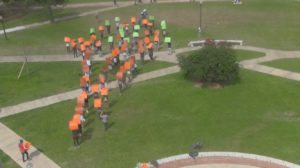 Actually conducting a mini-flash mob on the green, where students in the class brought their friends, and other students passing by were invited to participate, gave us the chance not only to test camera angles and the use of poster boards for visuals, but also allowed the students to figure out how they’ll indicate where everyone needs to stand, and how to best layout the shape of the torch on the green. The exercise helped demonstrate what worked well, and gave the students a clear path forward as they headed into the final week before Spring Break.
Actually conducting a mini-flash mob on the green, where students in the class brought their friends, and other students passing by were invited to participate, gave us the chance not only to test camera angles and the use of poster boards for visuals, but also allowed the students to figure out how they’ll indicate where everyone needs to stand, and how to best layout the shape of the torch on the green. The exercise helped demonstrate what worked well, and gave the students a clear path forward as they headed into the final week before Spring Break.
Week 07
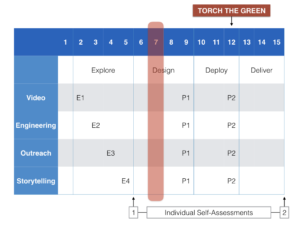 Week 7 kicked the design phase of the project into high gear, as each of the four teams considered their options and started to finalize their choices! Much time was spent exploring options for Video, Storytelling, Engineering, and Outreach, and the students engaged in a great deal of pre-testing in an attempt to learn what works and what doesn’t.
Week 7 kicked the design phase of the project into high gear, as each of the four teams considered their options and started to finalize their choices! Much time was spent exploring options for Video, Storytelling, Engineering, and Outreach, and the students engaged in a great deal of pre-testing in an attempt to learn what works and what doesn’t.
 The excitement was palpable as the students planned their outreach activities, designed and printed a sample 3D torch for use in the videos, created a flyer and a brief teaser trailer to advertise the event, worked on the structure of the story in the video, tested different engineering materials, and pulled together as a class to test camera options by floating a GoPro camera under a bunch of Happy Birthday balloons on Landis Green — successfully keeping the camera flat and centered while floating 50 feet up in the air!
The excitement was palpable as the students planned their outreach activities, designed and printed a sample 3D torch for use in the videos, created a flyer and a brief teaser trailer to advertise the event, worked on the structure of the story in the video, tested different engineering materials, and pulled together as a class to test camera options by floating a GoPro camera under a bunch of Happy Birthday balloons on Landis Green — successfully keeping the camera flat and centered while floating 50 feet up in the air!
Week 06
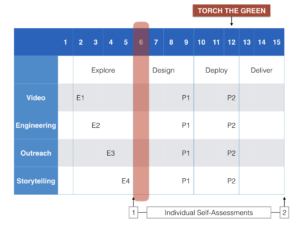 Week 6 began with the students sorted into their official teams for the first time, and kicked off the second phase of the course, the Design Phase! The students met in their teams — Team Video, Team Engineering, Team Outreach, and Team Storytelling — and determined what each team needs to contribute to the class project, what each student brings to each team, and how they will work together to create our #thrashmob to #torchthegreen.
Week 6 began with the students sorted into their official teams for the first time, and kicked off the second phase of the course, the Design Phase! The students met in their teams — Team Video, Team Engineering, Team Outreach, and Team Storytelling — and determined what each team needs to contribute to the class project, what each student brings to each team, and how they will work together to create our #thrashmob to #torchthegreen.
Each team prepared a (draft) list of milestones / action items that the teams will need to meet / complete to achieve the class goals by the end of the semester. The students were reminded that we are not just creating a flash mob here, but a video to promote Innovation at FSU that builds to the flash mob (in some way, to be determined) as its essential gimmick or central feature.
We spent a lot of time discussing the essential milestones coming up, including a pilot test of a smaller flash mob in class on March 2, the end of the Design Phase on March 9, and the beginning of the Development phase after the students return from Spring Break on March 21. The students then only have a few short weeks before the Torch the Green! #thrashmob on Landis Green at 2:00pm on April 6, and then only a couple of weeks after that to wrap up their video promoting FSU as a Center for Technological Innovation.
We took a class field trip to the top floor of Landis Hall to check out the video vantage points from that location, and we also had a guest speaker from the Department of Dance — Heather Boni — who discussed the Sky Art Projects that she has worked on with Daniel Dancer — http://www.artforthesky.com/ — with various student groups in Tallahassee. The students learned a lot from her presentation about different methods for coordinating group art projects. Finally, we continued to work with various groups on campus, including FSU’s Emergency Management program, to determine the best way to video our class project from above.
Week 05
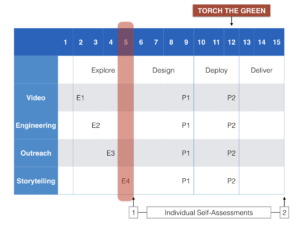 Week 5 wrapped up our last week of research and exploration — the tasks that will face Team Storytelling. We discussed again why we are working on this project — reminding the students that we aren’t just doing a flashmob, but positioning FSU as a Center for Innovation. That’s the story we want to tell, and we spent the week exploring how we could use digital media to tell that story… Castle Kim from the School of Information demonstrated different technology tools for digital storytelling and storyboarding, including Adobe Story, and then the students brainstormed possible storylines in small groups.
Week 5 wrapped up our last week of research and exploration — the tasks that will face Team Storytelling. We discussed again why we are working on this project — reminding the students that we aren’t just doing a flashmob, but positioning FSU as a Center for Innovation. That’s the story we want to tell, and we spent the week exploring how we could use digital media to tell that story… Castle Kim from the School of Information demonstrated different technology tools for digital storytelling and storyboarding, including Adobe Story, and then the students brainstormed possible storylines in small groups.
The students came up with many different ideas including how to best use the FSU Torch as a symbol of innovation, how the video can move (and grow and swell!) from start to finish, building excitement through the use of the flash mob. The students also came up with several different tag lines for the video, each presenting a different kind of approach to positioning FSU as a Center for Innovation — “FSU… Innovation everywhere you look!”, “… Where innovation burns brightly!”, ” … Where innovation ignites!”, — “FSU — Light Your Torch!” — all fantastic ideas! Finally, we worked with Ken Baldauf from the Program in Interdisciplinary Computing to talk about representative faculty, staff, and students that we could highlight in our video promoting FSU as a Center for Innovation, focusing on those individuals who have been selected to represent FSU at the ACC Innovation Festival, to be held at the Smithsonian Institution in Fall 2017.
The students ended this week by handing in their first individual self-assessment, which would be used to divide them into teams for the remainder of the semester.
Week 04
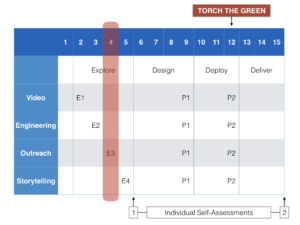 Week 4 turned the students’ attention to the challenges facing Team Outreach, including promotion and advertising, recruitment and coordination, scheduling and notifications, and integration with FSU’s innovation celebration – https://innovation.fsu.edu/events/celebration/. Two guest speakers, Kate Mullen and Alvaro Gabaldon, media specialists from the College of Communication and Information, shared their insights into the challenges of marketing, hype, and making a video go viral!
Week 4 turned the students’ attention to the challenges facing Team Outreach, including promotion and advertising, recruitment and coordination, scheduling and notifications, and integration with FSU’s innovation celebration – https://innovation.fsu.edu/events/celebration/. Two guest speakers, Kate Mullen and Alvaro Gabaldon, media specialists from the College of Communication and Information, shared their insights into the challenges of marketing, hype, and making a video go viral!
The students brainstormed many different options in small groups, including approaches to outreach such as flyers, teaser trailers, tabling on the green during class, working with different student groups and organizations, and using puppies to raise awareness. We talked about how, for the students, “you are your target market,” and explored what would make them want to be a part of this event. We also discussed how the different options for Team Outreach would need to integrate with the tasks of Team Video, Team Engineering, and Team Storytelling. Finally, the students were excited this week to learn that FSU President Thrasher was formally on board with this project, and ready to stand at the center of our flash mob! Based on the President’s availability during FSU’s Innovation Celebration, our official date and time for our #torchthegreen #thrashmob was officially set for Thursday, April 6 at 2:00pm.
Week 03
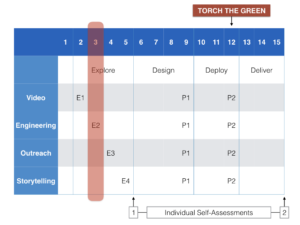 Week 3, the second of our research and exploration weeks, asked the students to focus on the actual mechanics of developing a flash mob and creating the physical devices that will feature in the video the class will produce — all tasks that will face Team Engineering. The students first spent time in small groups exploring 3D printing, 3D modeling, and 3D scanning, and examining how they might design and build a 3D-printed copy of the FSU Torch that could be presented to different innovators at FSU as part of the student video. We also took a class field trip out to Landis Green to do some initial measuring and determination of how many students would be necessary to successfully #torchthegreen.
Week 3, the second of our research and exploration weeks, asked the students to focus on the actual mechanics of developing a flash mob and creating the physical devices that will feature in the video the class will produce — all tasks that will face Team Engineering. The students first spent time in small groups exploring 3D printing, 3D modeling, and 3D scanning, and examining how they might design and build a 3D-printed copy of the FSU Torch that could be presented to different innovators at FSU as part of the student video. We also took a class field trip out to Landis Green to do some initial measuring and determination of how many students would be necessary to successfully #torchthegreen.
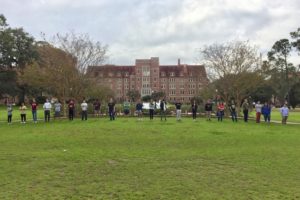 In group discussion, we broke the tasks facing Team Engineering down into two main categories — 3D Printing and Flash Mob Mechanics. With the former, we discussed how best to design a torch that matched FSU’s design; whether we’d need multiple sizes, colors, and materials; and whether we could design a torch with a light with a battery. With the latter, we explored how to layout the shape of the torch on the green, what materials to use to make the torch visible on video, and how to coordinate the crowd of students in the flash mob (to get them to animate the flame part of the torch, for instance). Finally, as part of the class discussion, we explored how each of the different tasks facing Team Engineering would need to integrate with the other teams — rigging cameras with Team Video, crowd communication and control with Team Outreach, and the different types of torches to be designed and built with Team Storytelling.
In group discussion, we broke the tasks facing Team Engineering down into two main categories — 3D Printing and Flash Mob Mechanics. With the former, we discussed how best to design a torch that matched FSU’s design; whether we’d need multiple sizes, colors, and materials; and whether we could design a torch with a light with a battery. With the latter, we explored how to layout the shape of the torch on the green, what materials to use to make the torch visible on video, and how to coordinate the crowd of students in the flash mob (to get them to animate the flame part of the torch, for instance). Finally, as part of the class discussion, we explored how each of the different tasks facing Team Engineering would need to integrate with the other teams — rigging cameras with Team Video, crowd communication and control with Team Outreach, and the different types of torches to be designed and built with Team Storytelling.
Week 02
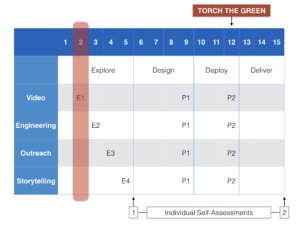 Week 2 kicked off our first of four weeks of research and exploration with the students exploring the different tasks that will face Team Video. Working in small groups, the students tried out many different video technologies, including audio-visual tech such as GoPro cameras, and 360-degree virtual reality setups such as Google Cardboard and Oculus Rift Virtual Reality devices. For inspiration, the students watched some videos of local Sky Art projects, such as this video showing hundreds of elementary school children in Tallahassee creating a swallowtail butterfly at DeSoto Trail Elementary School, https://www.youtube.com/watch?v=6HH2vl-JQiI&list=PLhrrLVxyXD3ujON5ZvFI2O18rYREfBvLg.
Week 2 kicked off our first of four weeks of research and exploration with the students exploring the different tasks that will face Team Video. Working in small groups, the students tried out many different video technologies, including audio-visual tech such as GoPro cameras, and 360-degree virtual reality setups such as Google Cardboard and Oculus Rift Virtual Reality devices. For inspiration, the students watched some videos of local Sky Art projects, such as this video showing hundreds of elementary school children in Tallahassee creating a swallowtail butterfly at DeSoto Trail Elementary School, https://www.youtube.com/watch?v=6HH2vl-JQiI&list=PLhrrLVxyXD3ujON5ZvFI2O18rYREfBvLg.
Many different ideas were generated in class as the students worked together to test different concepts and the format of the proposed class video started to come together. We reminded the students that the flashmob itself was only one feature (the central feature to be sure!) of our overall video promoting FSU as a Center for Innovation, and we discussed many different ways to presenting that video and incorporating the FSU Torch as a symbol of innovation. For instance, the different innovators profiled in the video could each be shown working with a different torch of their own creation, as the video takes the viewer from innovator to innovator, culminating with the flash mob on Landis Green showing a thousand students all working together to create a torch of innovation in person!
Week 01
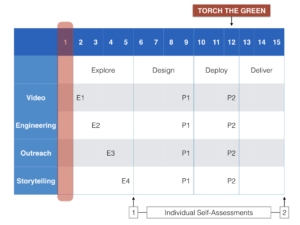 The students were introduced to the project idea on the first day of class, and they were immediately taken with the idea of doing something that had not yet been done before at FSU. We spent a lot of time during that first week talking about FSU as a center for technological innovation, and all the things we were going to have to accomplish in a short period of time if we were going to succeed with this project.
The students were introduced to the project idea on the first day of class, and they were immediately taken with the idea of doing something that had not yet been done before at FSU. We spent a lot of time during that first week talking about FSU as a center for technological innovation, and all the things we were going to have to accomplish in a short period of time if we were going to succeed with this project.
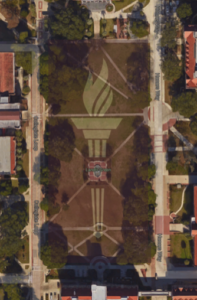 Much of our conversations focused on the meaning of technological innovation, and how to work with emerging technologies. We explored how FSU was moving forward with innovative technology, how Landis Green was being positioned as a new center for technological innovation on campus, and how this class project could help underscore that message. In particular, we talked about the message we want to deliver with our video — not just a flash mob, but promoting technological innovation at FSU!
Much of our conversations focused on the meaning of technological innovation, and how to work with emerging technologies. We explored how FSU was moving forward with innovative technology, how Landis Green was being positioned as a new center for technological innovation on campus, and how this class project could help underscore that message. In particular, we talked about the message we want to deliver with our video — not just a flash mob, but promoting technological innovation at FSU!
![]() We talked about the specifics of the project — from the numbers of students needed (approximately 1000) to the challenges of arranging a flash mob in general (e.g., what people would be carrying to be visible from above?). We watched an inspirational videos, including this music video from OK Go. We talked about recruiting FSU innovators to participate in our flash mob, and explored ideas such as having the students design and build 3D-printed torches that they could pass from innovator to innovator, who would then march with the students, in an ever-swelling crowd, across campus, where they would form the spark that “ignites” the flash mob “Torch of Innovation” on Landis Green.
We talked about the specifics of the project — from the numbers of students needed (approximately 1000) to the challenges of arranging a flash mob in general (e.g., what people would be carrying to be visible from above?). We watched an inspirational videos, including this music video from OK Go. We talked about recruiting FSU innovators to participate in our flash mob, and explored ideas such as having the students design and build 3D-printed torches that they could pass from innovator to innovator, who would then march with the students, in an ever-swelling crowd, across campus, where they would form the spark that “ignites” the flash mob “Torch of Innovation” on Landis Green.
We also discussed the plan for the semester in detail, which was divided into four different phases: Explore, Design, Deploy, and Deliver.
The first phase, Explore, would last for four weeks (Weeks 2-5 of the semester), and provide an opportunity for each student (working together in small groups, randomly assigned each week) to explore the requirements for successfully encouraging a thousand students from across campus to come together at the same time, on the same day, to create a giant flash mob in the shape of a giant “Torch of Innovation” on Landis Green. Each week would look at a different aspect of the project — Video, Engineering, Outreach, and Storytelling — and each group would keep detailed notes about what they learned, handing in their Explore Notes (E1, E2, E3, and E4) at the end of each week.
After exploring each topic in detail, the students would be divided into teams based on their interests, and then spend four weeks (Weeks 6-9) designing the project — coming up with the plans for everything we would need to Torch the Green! The idea was to have everything planned out by the time the students left for Spring Break (which occurred between weeks 9 and 10 of the semester). Each group would hand in their first Progress Report (P1) at the end of this phase.
After Spring Break, the students would then spend three weeks (Weeks 10-12) deploying their ideas, culminating in the actual flash mob on Landis Green during Week 12. Each group would hand their second Progress Report (P2) at the end of this phase. We would then spend the final three weeks of the semester (Weeks 13-15) delivering our final project, including creating and sharing the flash mob video.
Along the way, the students would complete two individual self-assessments detailing what they were learning from the course at the end of Week 5 (documenting lessons learned from the Explore phase), and the end of Week 15 (detailing what they had learned from the class overall).
Week 00
IFS 2097, Emerging Technologies, was offered in Spring 2017 as an E-Series course in FSU’s Liberal Studies program, which looked to provide undergraduate students with opportunities to work together in small groups on hands-on, project-based activities. The purpose of IFS 2097 was to engage students with emerging technologies available in the School of Information’s Goldstein Library, and was advertised to prospective students with the following description:
Calling all students for this interactive, high energy, and hands-on Honors E-Series course highlighting emerging technologies! Our goal for the Spring 2017 semester will be to create a unique, student-driven project, centered on Landis Green, that showcases FSU’s talents in technological innovation! To accomplish this, we will spend the semester mastering a wide variety of technical skills blending digital and social media, creative arts and writing, mechanical engineering, and emerging information technologies! Don’t miss this opportunity to shape the future of technological innovation at FSU!!
This was the second time this course was offered (in 2016, students launched a 3D printed copy of the FSU torches into space on a weather balloon), and this year, we decided to have the students tackle a brand new challenge, never before done on campus — designing a flash mob to create the largest torch possible on FSU’s Landis Green. As with the previous year, the overarching goal of the class was to use the challenge to promote FSU as a center for technological innovation.
The structure of the semester (beginning with four weeks of exploration, followed by four weeks of design) was planned to ensure the students retained as much ownership as possible over the project — researching all the options available to them, and figuring out for themselves exactly what they wanted to design and how they would do it. This year’s theme — Torch the Green! — also provided an opportunity to connect the course to FSU’s ongoing capital campaign — Raise the Torch.